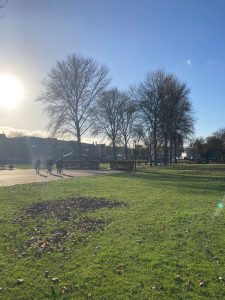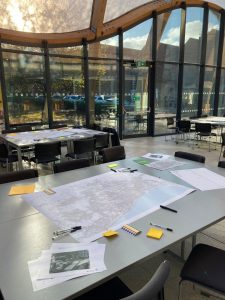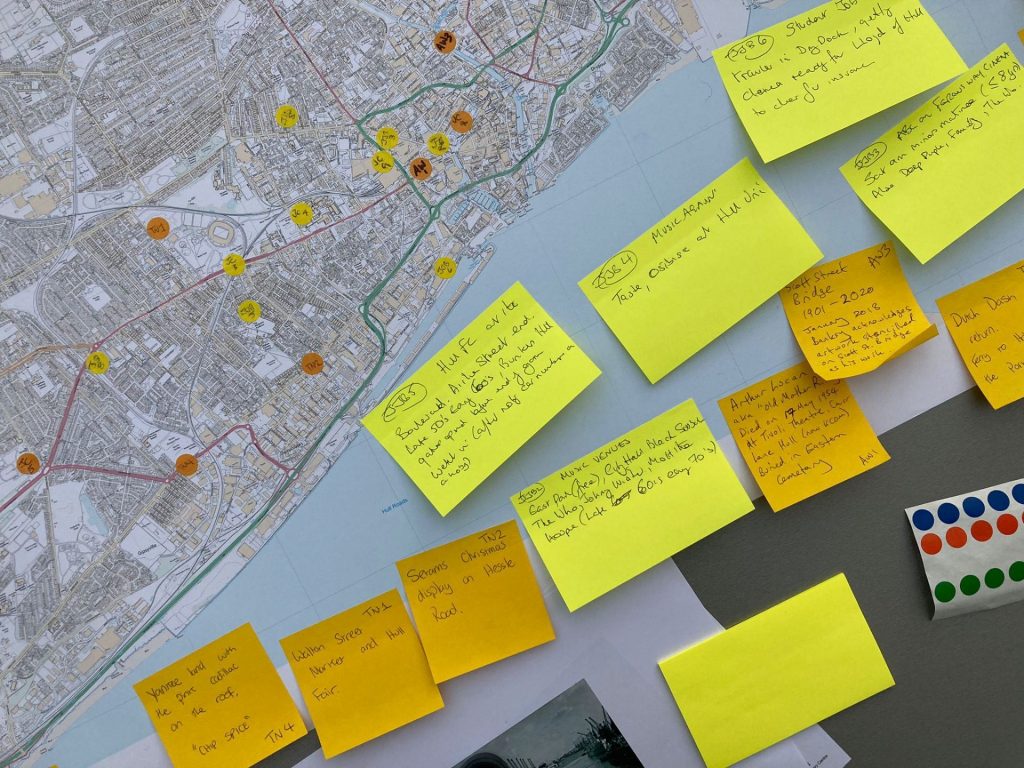The Half Life of the Blitz project is all about people and the stories they tell about the places they live. Talking to people is at the core of our project, as we create a new history of post-war Hull built from people’s experiences, their memories, and what matters to them.
With that in mind, we knew we wanted our first project event to get right to the heart of what we’re trying to do – talk to as many people as possible about living in Hull and what the city means to them. We planned a relaxed, interactive, and fun afternoon which would kick off the project, our first public event (and also the first event that our project partners the Hull History Centre had hosted since the start of the pandemic).

We had three aims for our workshop:
- First, we wanted to introduce more people to the project. Hosting a public workshop was a great way to engage members of the public and allow people to start taking part straight away.
- Second, we wanted a conversational, collaborative session which would encourage people to share their memories of the city (with each other and with us), and we wanted to begin collecting some of these stories, which could then be added to our online Memory Map.
- Finally (and most importantly), we want all of our workshops to inform our research design, shaping what we will do over the next couple of years. We planned this first session as an informal consultation, where we could find out more about what stories, places, themes, and issues were important to people – and take this information forwards to refine our research interests and methodologies.
So, our first workshop revolved around the following questions: What are people’s experiences of living in and around Hull over the past 80 years? What stories do people think should be included in a history of the city since 1945? What stories do they tell about their lives here? What does Hull mean to people in the area today, and what has it meant in the past?
Monday 22nd November was a cold but sunny autumn day, and we started the workshop with a “chatty walk” around the city centre. We walked from Ferens Art Gallery in Queen Victoria Square (a public space at the heart of the city centre, and a great meeting point) to the Hull History Centre, taking a historically-scenic route over the course of 40 minutes. Ran as an informal guided tour, with a heavy emphasis on group participation and conversation, in this half of the workshop the group explored stories of Hull’s experience in the Blitz during the Second World War, 1950s time capsules buried underground, and shopping centres built on the sites of old hospitals and retired docks (told by the guide), as well as stories of local family businesses, much-loved and long-gone restaurants, and easy-to-miss architectural details (told by the attendees).


Once we arrived at the History Centre, we enjoyed cups of tea, coffee and biscuits, and continued the discussions about Hull, place, and memory over some contemporary and historic maps, as well as archival photos and blank timelines – all prepared for the attendees to annotate, discuss, and add their stories to. While typical archival workshops often involve carefully handling objects and historical records in a controlled setting, it was important to us that our attendees could get really comfortable, handle the materials freely, and scribble all over them with their thoughts, memories, and suggestions. This approach seemed to work well – people had rich conversations about the city that lasted well beyond the allotted two hour time-slot and we left with more than 80 contributions in the form of annotations, post-it notes, and longer written accounts.
The stories shared were, unsurprisingly, wide-ranging, but similar themes did crop up again and again. For example, lots of our attendees talked about their childhoods in Hull – where they lived, went to school, or where and how they played as children – and where they and their family members have worked over the years.
“Saturday was my favourite day of the week. From age 12 I was allowed to go into town with friends. We would go to Picadish in Hammonds for a sausage and chips and then spend ages listening to music in the booths in the record dept.”
“I lived in a prefab. It was a luxury to some people. We had a bath, an inside toilet, and a fridge. We also had a garden and shed.”
Other recurring stories were more specific, common experiences of living in Hull – such as swimming in the city’s ‘Slipper Baths’ or enjoying open-air concerts in East Park. More stories were told about the 1950s, 1960s, and 1970s than other periods, but there were also some memories of the 21st century shared – such as volunteering during Hull’s year as UK City of Culture in 2017, or trips to Belgium and the Netherlands on the P&O ferry service that runs from Hull.
“I don’t think I’d ever been to Humber Street before 2017. That has changed so much even during my short time here. It’s so lively now. I love helping at Humber Street Gallery.”

Stories like these show us why collaborating with members of the public is so important to our project. Accounts like these are a huge source of local expertise, and in just one afternoon we learned lots about Hull that we hadn’t heard about before (like the fact that the Dairycoates area used to be known as Dairy Cottages, or that popular fast food chain Chicken George has links to Hull Fair). But collaborating isn’t just about exchanging knowledge – in our workshop we were also able to learn more about what’s important to local people, which aspects of our history they value most. Attendees were invited to become our research partners, rather than just participants, and this is crucial in shaping what we do next.
For example, we’ll use the suggestions and stories contributed in our first workshop to shape what we investigate through our research over the next two years. Some of our attendees will be taking part in our oral history interview series, starting in the new year, and eventually they’ll be able to help us put together an end-of-project exhibition at the Hull History Centre. The material we gathered in our session is being added to our online Memory Map, where attendees can continue to add stories, expand on their contributions, make suggestions, and talk to one another, creating an evolving picture of what the city means to people – and other members of the public are invited to join in this conversation online too.
And, as we plan our next events, we’ll be reflecting on what worked well in our first workshop, and what activities we could introduce to facilitate and capture what else people wanted to talk about and tell us – the topics, stories, and ways of sharing that spilled over the boundaries of our chatty walks and mapping exercises.
We’d like to thank all the attendees of our first project workshop, and the support of the HEY Volunteering programme. In the new year we’ll be hosting more events which you can hear about here and by following us on social media. We’ll also be launching the next phase of our project, an oral history series recording people’s stories of Hull. If you’d like to know more or sign up to take part, please get in touch.